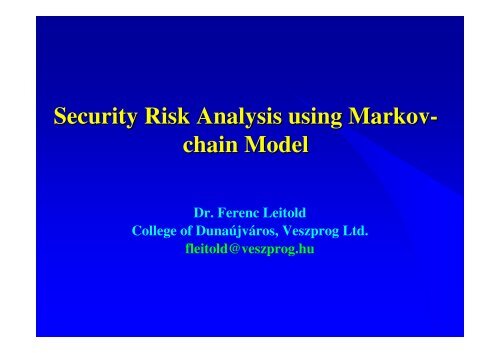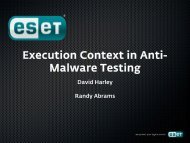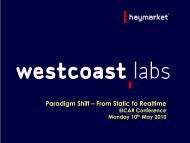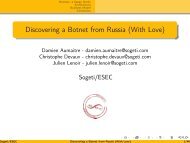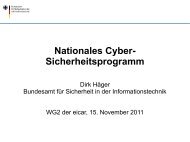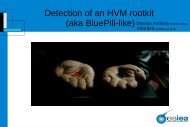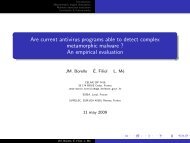Security Risk Analysis using Markov- chain Model - Eicar
Security Risk Analysis using Markov- chain Model - Eicar
Security Risk Analysis using Markov- chain Model - Eicar
You also want an ePaper? Increase the reach of your titles
YUMPU automatically turns print PDFs into web optimized ePapers that Google loves.
<strong>Security</strong> <strong>Risk</strong> <strong>Analysis</strong> <strong>using</strong> <strong>Markov</strong>-<br />
<strong>chain</strong> <strong>Model</strong><br />
Dr. Ferenc Leitold<br />
College of Dunaújváros, Veszprog Ltd.<br />
fleitold@veszprog.hu
Agenda<br />
Traditional attacks<br />
Attacks nowadays<br />
Theory of <strong>Markov</strong>-<strong>chain</strong>s<br />
Using <strong>Markov</strong>-<strong>chain</strong> in the security risk<br />
analysis
Traditional attacks
Traditional attacks
Traditional attacks
Traditional attacks
Traditional attacks
Attacks thru communication channel<br />
Based on message (packet) sending<br />
SOURCE: user or application<br />
TARGET: user or application
Attacks thru communication channel<br />
The target is (mainly) the user:<br />
(email, skype, msn, ICQ, IRC, phone, …)<br />
• Code is sent within the message (e.g. attachment)<br />
– Abuse the user AND / OR<br />
– Execute the code automatically<br />
• Code is not sent<br />
– The user executes the required activity<br />
• The user sends the message toward (e.g. HOAX)<br />
• The user executes manually the malicious activity<br />
– Link of malicious code or URL in the message<br />
(e.g. phishing)
Attacks thru communication channel<br />
The target is an application:<br />
Vulnerability problem<br />
It can be related:<br />
– operating systems<br />
– applications<br />
– protocols<br />
– “file formats”<br />
(applications handling particular files)
Attacks thru communication channel<br />
Two problems:<br />
- the user<br />
- vulnerabilities<br />
Both of them are related to the human factor.<br />
“The biggest problem with computers is the bit<br />
between the keyboard and the chair.”
Example:<br />
Theory of <strong>Markov</strong>-<strong>chain</strong><br />
<strong>Markov</strong> <strong>chain</strong><br />
Homer and Marge repeatedly play a<br />
gambling game. Each time they play,<br />
the probability that Homer wins is 0.4, and<br />
the probability that Homer loses is 0.6<br />
Homer and Marge both start with $2
Theory of <strong>Markov</strong>-<strong>chain</strong><br />
<strong>Markov</strong> <strong>chain</strong>
Theory of <strong>Markov</strong>-<strong>chain</strong><br />
<strong>Markov</strong> <strong>chain</strong>
Theory of <strong>Markov</strong>-<strong>chain</strong><br />
<strong>Markov</strong> <strong>chain</strong>
Theory of <strong>Markov</strong>-<strong>chain</strong><br />
<strong>Markov</strong> <strong>chain</strong>
Theory of <strong>Markov</strong>-<strong>chain</strong><br />
<strong>Markov</strong> <strong>chain</strong>
Theory of <strong>Markov</strong>-<strong>chain</strong><br />
<strong>Markov</strong> <strong>chain</strong>
Theory of <strong>Markov</strong>-<strong>chain</strong><br />
<strong>Markov</strong> <strong>chain</strong>
Theory of <strong>Markov</strong>-<strong>chain</strong><br />
<strong>Markov</strong> <strong>chain</strong>
Example:<br />
Theory of <strong>Markov</strong>-<strong>chain</strong><br />
<strong>Markov</strong> <strong>chain</strong><br />
Homer and Marge repeatedly play a<br />
gambling game. Each time they play,<br />
the probability that Homer wins is 0.4, and<br />
the probability that Homer loses is 0.6<br />
Homer and Marge both start with $2
Theory of <strong>Markov</strong>-<strong>chain</strong><br />
<strong>Markov</strong> <strong>chain</strong><br />
0 1 2 3 4<br />
P(Homer wins) = .4 P(Homer loses) = .6<br />
0<br />
1<br />
2<br />
3<br />
4
A <strong>Markov</strong>-<strong>chain</strong> is a mathematical<br />
model for a process which moves step<br />
by step through various states.<br />
In a <strong>Markov</strong>-<strong>chain</strong>, the probability that<br />
the process moves from any given state<br />
to any other particular state is always the<br />
same, regardless of the history of the<br />
process.<br />
Theory of <strong>Markov</strong>-<strong>chain</strong><br />
<strong>Markov</strong> <strong>chain</strong>
Theory of <strong>Markov</strong>-<strong>chain</strong><br />
<strong>Markov</strong> <strong>chain</strong><br />
A <strong>Markov</strong>-<strong>chain</strong> consists of states and<br />
transition probabilities.<br />
Each transition probability is the probability of<br />
moving from one state to another in one step. The<br />
transition probabilities are independent of the past,<br />
and depend only on the two states involved. The<br />
matrix of transition probabilities is called the<br />
transition matrix.
Theory of <strong>Markov</strong>-<strong>chain</strong><br />
<strong>Markov</strong> <strong>chain</strong><br />
from 0 1 2 3 4<br />
to<br />
0<br />
1<br />
2<br />
3<br />
4
Theory of <strong>Markov</strong>-<strong>chain</strong><br />
<strong>Markov</strong> <strong>chain</strong><br />
If P is the<br />
transition matrix for<br />
a <strong>Markov</strong> Chain,<br />
then the nth power<br />
of P gives the<br />
probabilities of<br />
going from state to<br />
state in exactly n<br />
steps.
Purpose of modelling<br />
Calculating or estimating a metric which typifies<br />
how immunized is an infrastructure (in a<br />
particular environment and in a certain time)<br />
against attacks arriving from different<br />
communication channels.
Problems Problems<br />
Everything is changing<br />
– Attack possibilities<br />
– Malware (used attack vectors, prevalence,<br />
geolocation)<br />
– Known and/or published vulnerabilities<br />
– Update of elements in an IT system<br />
– User knowledge about security<br />
– …
Graph representation
Graph representation
A[i,j]:<br />
Matrix representation<br />
The “risk of attack” on the E j ���� E i<br />
communication channel<br />
If Σ A[i,j] = 1<br />
j<br />
<strong>Markov</strong>-<strong>chain</strong> model
A[i,j] = 0<br />
Matrix representation<br />
E i is not attackable thru the E j ���� E i<br />
communication channel<br />
A[i,j] > 0<br />
• Reliability, attack possibility of the<br />
communication channel.<br />
• Reliability, vulnerabilities, security updates<br />
of entity i.
<strong>Risk</strong> analysis<br />
Input<br />
- Elements of IT infrastructure: topology,<br />
protocols, versions, …<br />
<strong>Security</strong> tools: types, versions, settings, …<br />
- Contacts of users (with each other and with<br />
IT elements): results of questionnaires, tests<br />
of their security level<br />
- Properties, prevalence and geolocations of<br />
possible attacks (malware)
<strong>Risk</strong> analysis<br />
Output<br />
- <strong>Security</strong> risks of the elements of IT<br />
infrastructure<br />
- The weakest point of the IT infrastructure


